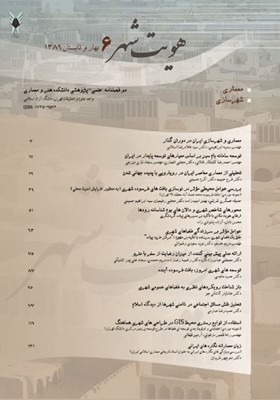معماری و شهرسازی ایران در دوران گذار
محورهای موضوعی : معماریسمیه ابراهیمی 1 , سید غلامرضا اسلامی 2
1 - دانشجوی دکترای تخصصی معماری، دانشگاه آزاد اسلامی، واحد علوم و تحقیقات تهران، ایران. (مسئول مکاتبات)
2 - استادیار دانشکده معماری، پردیس هنرهای زیبا، دانشگاه تهران
کلید واژه: Network Society, Modernity, مدرنیته, معماری معاصر, بحران هویت, جامعه شبکهای, Modern architecture, Identity Crisis, contemporary architecture, Construction, معماری مدرن, ساخت وساز,
چکیده مقاله :
معماری ایران برای باز یافتن جایگاه ویژه خود راه دشواری پیش رو دارد، زیرا با جامعه ای در حال تحول روبروست که جریان های صنعتی شدن، جهانی شدن و شبکه ای شدن را تجربه می کند. هنر و معماری در چنین موقعیتی نقش موثری در بازتعریف هویت (زمانی که بحران هویت بزرگترین چالشی است که انسان با آن مواجه است) خواهند داشت. گذار از جامعه سنتی به مدرن و جامعه مدرن به شبکه ای در تمامی دنیا در حال بروز است و تاثیرات مطلوب و نامطلوب خود را بر جوامع می گذارد. جامعه ایران نیز دوران گذار از جامعه سنتی به مدرن را بسیار سریع و بدون ایجاد زیرساخت های لازم علمی، فرهنگی و هنری تجربه نموده است. در چنین شرایطی ظهور جامعه شبکه ای نیز در بطن جامعه ایرانی در حال وقوع است. برای ایجاد کالبد مناسب، گام نخست شناخت وضعیتی است که با آن مواجه هستیم. لذا معماری معاصر ایران در دهه اخیر نقد گردیده است.
Iran contemporary architecture is in a critical situation because our society is changing by industrialization, globalization and today by information revolution. Art and architecture have a great role to make our identity and society organization. Transmission from traditional society to modern and then network society, have made many pleasant and unpleasant influences on our life style, behavior, collective wisdom and also on our physical world, environment, cities and buildings. Iranian society experienced transmission from traditional to modern society without any scientific, cultural, educational, artistic infrastructures. Today, emergence of network society, influenced every aspects of our life and have a great challenge by tradition and its rules. The transition term means changing from one status to another status that has been occurred during a period of time, creating new things and transforming many existent identities. Therefore, the transition era as an “indefinite period of time” is an effective and challenging period during our history. Studying this period of time can assist the societies to understand the changes in a better way and to reorganize all their infrastructures, thereby immune themselves against lack of development in all fields and its consequences. Nowadays, The Iranian society faces with another transition to the network society for which some of the initial infrastructures underpinned by telecommunication and information technologies had been established. The raise of speed reduced the required time for occurring the eventualities and in contrast to the past that transition from agriculture to industry had taken many centuries, transition to electronic world and network society occurs in a shorter period of time. These changes occur so fast that failure to detect the status will face the societies with shocks and their consequences in the future. Sufficient knowledge and good plan for the predictable future can help the society to pass through the crises of transition period in all fields and benefited from changes in favor of all fields. The first step of this research is to know about our situation and transmission era to make new sustainable structure for our societies and our physical world. In this article our focus is on Iran contemporary architecture, specially in the last decades. Technology and modernization have changed our physical world. Our cities have a great physical growth in the last three decades. Iran architecture today is suffering from abnormal, odd, unreasonable constructions which mostly have made by a confused society not architects. Illness of economy, unreasonable politics and programs make great disorders in the body of our cities. Today also we can find a few masterpieces of architecture which can make our identity in new era of modernization and globalization. the role of architecture in the world in which the borders are crossing out, traditional societies are demolishing, network societies are developing, reality and virtuality are extremely close together, collective intelligence is replacing individualism, patriarchy families are destructing, human bodies are equipping with electronic tools, environment is stepping forward toward destruction and resource depletion, information viruses are spreading, will be explained briefly in this article.
- ابراهیمی، سمیه، (1388). «معماری و چالشهای پیش رو در گذار به جامعه شبکهای»، مجله معماری و شهرسازی، بهار و تابستان88، شماره 95-94.
2- اخترکاوان،مهدی، (1386). «بحران در معماری و اندیشه معاصر»، مجله معماری و ساختمان، زمستان 85 و بهار86، شماره 12.
3- باکاک، رابرت، (1386). «صورتبندیهای فرهنگی جامعه مدرن»، ترجمه مهاجر، انتشارات آگاه، تهران .
4- بانک اطلاعات معماری نوین ایران.
5- تی.هال، ادوارد، (1384). «بعد پنهان»، ترجمهُ طبیبیان، انتشارات دانشگاه تهران، تهران.
6- حبیبی، محسن، (1385). «شرح جریانهای فکری معماری و شهرسازی در ایران معاصر»، دفتر پژوهشهای فرهنگی، تهران.
7- قبادیان، وحید، (1383).«مبانی و مفاهیم در معماری معاصر غرب»، دفتر پژوهشهای فرهنگی، تهران.
8- کاستلز، مانوئل، (1380). «عصر اطلاعات: اقتصاد، جامعه و فرهنگ (ظهور جامعه شبکهای)»، ترجمهُ علیقلیان، خاکباز، انتشارات طرح نو، تهران.
9- کاستلز، مانوئل، (1380). «عصر اطلاعات: اقتصاد، جامعه و فرهنگ (قدرت هویت)»، ترجمه چاووشیان، انتشارات طرح نو، تهران.
10- لیمن، جنیفر، (1385). «ساخت شکنی دورکیم (نقدی پساپسا ساختارگرایانه)»،ترجمه مسمی پرست، نشر نی، تهران.
11- بانک اطلاعات معماری نوین ایران.
12-Hight,Christophe&Chris, Perry. (2006). “collective intelligence in design”,AD magazine ,volume76, no5.
13-Islami, S. Gh. R., (1998). “Endogenous Development: A Model for the Process of Man-environment Transaction”, unpublished PhD Thesis, Heriot-Watt University , Faculty of Environmental Studies, Edinburgh College of Art, Department of Architecture, Edinburgh, U.K.
14-Salingaros Nikos A. (2002). “Design methods, emergence, and collective intelligence”, Department of Applied Mathematics.
15-Salingaros Nikos A. Terry M.Mikiten, (2002). “Darwinian process and memes in architecture:a memetic theory of modernism”, DATUTOP journal of Architectural theory23:117-139.
16- http://en. wikipedia.org
17- www.worldisround.com
_||_

